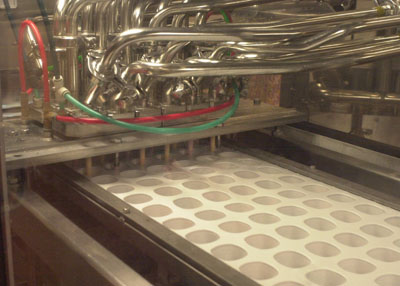By Margie Wuebker
mwuebker@dailystandard.com MINSTER -- June may be National Dairy Month but The Dannon Company salutes the dairy industry month in and out by producing yogurt in a wide range of flavors from banana to vanilla.

The sprawling plant located along Ohio 66 at the south edge of this Auglaize County community holds the distinction of being the largest yogurt manufacturing plant in the world, producing 230,000 cups per hour or 3.5 million cups per day.
The 330,000-square foot facility, located on 30 acres, will be growing in the future to add beverages to its line of cup yogurts. By 2006, the Minster facility will produce Frusion and Lite 'n Fit smoothies to supply Midwest and East Coast markets. Dannon plants in Fort Worth, Texas, and West Jordan, Utah, currently manufacture the dairy-based smoothies that have become popular in today's on-the-go society.
"We missed the boat here in Minster when it comes to yogurt drinks," plant manager Timothy Burgess says. "There is no room in the existing plant to add production of new lines. However, we plan to correct that with investments beginning this year."
Forty-five tanker trucks arrive each day carrying raw milk produced primarily on farms within a 60-mile radius of the plant. The majority of the farms supplying Dannon have herds of 100 dairy cattle or less. "The receiving operation goes on 24 hours per day seven days a week," Burgess says. "The quality of the milk produced in this area is exceptional with lower bacteria and higher protein counts than milk coming into other plants."
The Minster facility has earned the distinction of being the place to launch new products like La Creme introduced in April 2003 and Carb Control in January of this year. The new kid on the yogurt block has 80 percent less sugar than regular lowfat yogurt and just 3 grams of carbohydrates per 4-ounce serving.
Computers control virtually all aspects of the production process with monitors tracking what is taking place at each station. Cream is removed from the raw milk for sale to other food-related producers. The milk then flows to the batch area where ingredients are added in precise amounts before heading toward huge tanks. Unique live and active cultures are added to cause the fermentation process that gives yogurt its distinctive custard-like consistency.
Once selected fruit or other flavorings such as vanilla have been added, the yogurt travels to the packaging area where machines deliver a measured flow into cups of varying sizes before sealing and dating the cups to ensure quality. Employees maintain constant surveillance as the machines yield six pallets of yogurt products per hour with each pallet containing 264 cases.
Random samples are taken from each pallet and brought to the lab where technicians run Ph tests to determine whether the optimum acidity level has been reached. The pallets then move from a warm atmosphere into a cold one to slow down the action of the cultures.
The yogurt-making process takes 12 hours from the time the milk tankers roll up to the dumping station until filled pallets move into cold storage. The stacked pallets remain two to three days before heading to Midwest and East Coast markets representing a 60 percent share of all United States markets.
Three employees -- Ivan Bergman of Minster, Ed Hoehne of Newport and Dick Wenning of Maria Stein -- remember a much slower pace when yogurt production began locally Oct. 28, 1968, at the Meyer's Dairy building behind the Minster Tasty Treat. Some 13,646 cups rolled down the line the first day with much of the work performed manually. Production was limited to just two days a week with the finished product heading to a Detroit branch for distribution. Some 1.2 million cups of yogurt were produced during the first year representing a milestone at that point.
Dannon continues to achieve new milestones with quality products and new goals for the future. The current five-year objective calls for the production of yogurt drinks as well as reducing energy usage by 15 percent and water usage by 25 percent.
"Minster has been good to Dannon," Burgess says. "And Dannon has been good for Minster as well as the surrounding area. Together, we have grown and prospered." |

